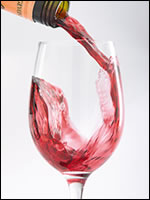Our expectations about the world have all sorts of knock-on effects for how we behave. Take something as simple as eating and drinking. If I give you a glass of wine, telling you to expect a taste-explosion, unless you’re an expert, you’re likely to experience it as being tastier than if I told you it was some cheap rancid rubbish I had lying around.
Not only that, this expectation might well be passed on to other aspects of your behaviour, such as the amount of accompanying food you eat. Don’t believe me? Check out this experiment by Wansink, Payne and North (2007).
The experiment
Thirty-nine unknowing participants sat down to a meal in a University restaurant. Half were served a glass of wine labelled as from California, the other half saw labels from North Dakota. A previous study had found that people had greater quality expectations of wine from California than that from North Dakota.
Actually both groups had been served the same wine, a Charles Shaw Cabernet Sauvignon costing $2.99. All were then served the same three-course meal with the weight of food carefully measured before and after they had eaten.
By measuring the difference, the researchers found that those served wine they thought was from California ate 12% more than those who thought their wine was from North Dakota.
So it seems that expectations of wine quality can affect how much food we eat.
Social facilitation?
But, what else could explain this difference in the amount eaten apart from the wine? Perhaps it was the social groups at each table? After all, you’re likely to eat more if you’re sat with other people who are wolfing it down, and less if others are all prodding their food as if it were poisonous.
To test this possibility, the authors carried out statistical tests to compare between tables. They reasoned that if social groupings were causing this difference then the tables at which participants sat would be a better predictor of the amount of food eaten than perceptions about the wine. But, again, it was perceptions about the wine that better predicted the amount of food eaten, not social groupings.
Interestingly, although perceptions about wine increased the amount of food eaten, they didn’t increase the amount of the actual wine that was drunk. Surely, on average, diners would drink more of the wine they perceived as higher quality? The authors argue, however, that because all diners were restricted to a single glass, they didn’t have the opportunity. So that’s a question for future research.
Explanations
What mechanism might, then, connect expectations about wine with eating more food? Here’s three the authors offer:
1. It could be that expectations about wine ‘leak across’ to the food: if the wine is good, the food should be good as well. So more chomping.
2. More drinking the ‘tasty’ wine decreases self-restraint leading to more chomping.
3. Greater enjoyment of the wine leads to better overall wine+food experience. And so more chomping.
Or, indeed, any combination of these three!
Reference
Wansink, B., Payne, C.R., & North, J. (2007). Fine as North Dakota wine: Sensory expectations and the intake of companion foods. Physiology & Behavior, 90(5), 712-716.

